HMS Daring has been out of service for over 3,000 days — longer than it took to build her. Now, after years of refit and regeneration, she is crewing up for trials and getting ready to rejoin the fleet.
The milestone, reached this week, highlights the length of time the destroyer has spent undergoing refit and regeneration since she was withdrawn from the fleet in 2017.
Daring was laid down in 2003, launched in 2006, and commissioned in 2009. From keel-laying to commissioning, the process took 2,307 days. In contrast, the destroyer has now spent more than 3,000 days out of service, exceeding the entire period it took to build and bring her into the fleet.
The ship was withdrawn in April 2017 to begin the Power Improvement Project (PIP) and a major refit. The PIP was introduced across the Type 45 class to address known limitations with the ships’ power and propulsion systems. The original WR-21 gas turbines, which included an intercooler unit, had caused reliability issues in warm climates.
This milestone has also been covered by the excellent Freddy Webb at the Portsmouth News, with whom we worked in following up developments.
The upgrade package replaced the two original diesel generators with three larger and more reliable units. For Daring, this engineering programme was combined with a broader refit carried out at the Cammell Laird shipyard, which concluded in late 2022. After returning to Portsmouth in early 2023, Daring entered the regeneration phase. Then-Defence Minister James Cartlidge confirmed in May 2023 that PIP work had been completed, alongside that of HMS Dauntless. Dauntless has since returned to active service, while Daring has remained alongside undergoing further work.
According to defence sources, HMS Daring has now begun crewing ahead of trials. Planning indicates that shakedown could begin in December 2025, though January 2026 is considered the more likely timeframe. This would mark the ship’s first time at sea since leaving service more than eight years ago.
The other five Type 45 destroyers are at different stages of the same process. HMS Dauntless has returned to operations after completing her PIP work, HMS Dragon is currently progressing through the upgrade, and HMS Defender is due to begin. HMS Diamond and HMS Duncan will follow. Current plans envisage that all six destroyers will have completed the programme by 2028. Parliamentary statements have confirmed that no PIP-related technical issues have been reported on ships that have completed the work.
Officials have also stressed that the Royal Navy continues to meet operational demands across the globe despite individual ships being out of action. A Royal Navy spokesperson said: “We do not comment on the material state of our ships, but the Royal Navy continues to fulfil all of its operational commitments.”
Perspective
The 3,000-day milestone places HMS Daring’s regeneration period in context when set against her earlier career. From commissioning in 2009 until withdrawal in 2017, she spent eight years in operational service. Since then, she has spent more than eight years out of service. If she returns to sea trials in early 2026, the balance between those two phases will be almost even.
The length of this period is not the result of a single factor. The Power Improvement Project required deep modifications to the ship’s machinery spaces, and this was combined with a major refit at Cammell Laird. After Daring’s return to Portsmouth in 2023, the focus shifted to regeneration: systems testing, certification, and assembling and training a crew for a ship that had been inactive for years. Each of these stages has contributed to the overall timeline.
Across the class, the PIP has been designed to deliver long-term reliability, ensuring that all six destroyers remain capable of fulfilling their role as advanced air defence platforms into the future. Parliamentary statements have noted that no technical issues have been reported with the ships that have already completed the conversion.
That said, the fact that Daring has now spent longer out of service than it took to build her is bound to draw attention. Some will see it as an unwelcome milestone or a source of embarrassment. For others, it will be viewed as a necessary stage in maintaining the Royal Navy’s most complex surface combatants.
Our role is not to smooth over or exaggerate either view, but to set out the facts as they stand. The purpose of this article is to inform, and that means reporting on both the positive progress and the difficult milestones alike.


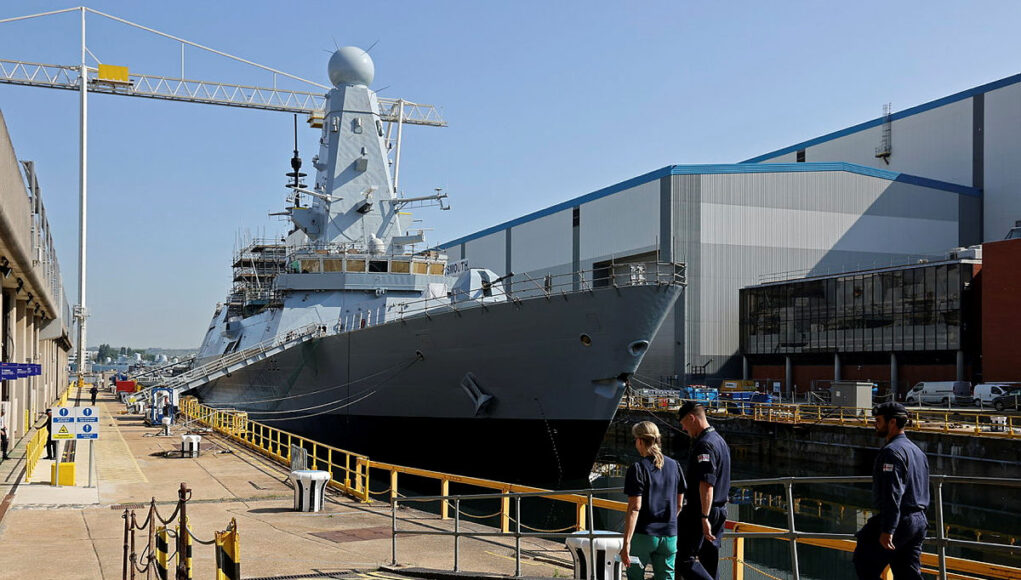
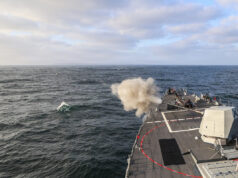
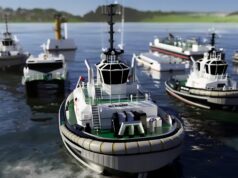
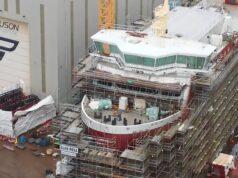
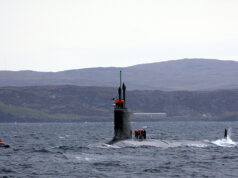
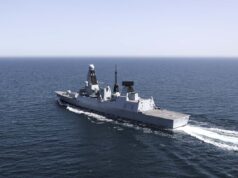


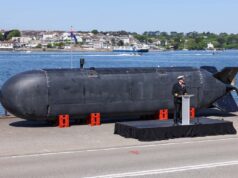
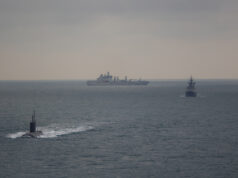
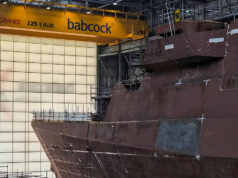

Comments section about to get “lit”!
#Day3000
Not worth it is it? Just proves how incapable industry really is.
To be honest, I thought the headline was a joke until I read the full post.
Yup, politeness stops peoples true feelings I guess.
Huh?
Personally I think it appropriate that the first T45 should get all the upgrades which will set the benchmark for the whole type. We are nearly there and Daring is not needed at the moment. Seems a sensible move.
May as well upgrade her now.
And why not some mk41s / Exls in the “gym slot” on these T45s? Get the CAMM and overall load count and missile options up now. All the talk about increasing lethality”, here’s a chance to do more of that! The T31s can be made with a hybrid mix of mk41s and CAMM farms.
Has she received all the upgrades or is the CAMM upgrade still due to be undertaken?
It’s just very easy to blame industry but fact is its the Politicians who decide haow and when to spend the money needed for industry to do the job. No one mentions that the decisions made back then were based on cost, the entire WR21 Recuperative IEP system was an industry 1st and way beyond anything attempted elsewhere.
The main problem was someone in the Treasury (probably with a 1st calss degree in Ancient Greek), decided to save money and tell HMG to not fund an onshore test facility for this revolutionary system. And we are not alone in doing this sort of thing’ the US ordered the LCS1 class with a completely untried and new to the USN propulsion system a RR MT30 GT combined with 2 different makes of DG sets and with an untried Gearbox to combine them all and to provide a 40 + Knot ship.
Now you know why the New US Frigate is taking so long to build; as depsite it using the same propulsions system as the Italian FREMMS the US decided to test on shore 1st.
Oh and don’t go blaming RR either the WR21 worked just fine and the MT30 is rapidly becoming the No1 choice for GT in the western world.
The new USN Frigate is taking so long because the USN has basically thrown the FREMM design in the bin and making it up as they go along.
Quite.
No point is shore testing, again, if you can get plenty of data from actual ships.
Exactly. The U.K. is not alone in any of these issues developing and deploying new and complex systems. Duds happen to everyone who tries new technology. I wonder if resident brains here know if running down our sovereign capacity in ship building this century has had an impact on this timescale? Only experienced need apply.
Geoff Hoon overrode BAe and RR to order the Northrop Grumman intercooler . Bae and RR wanted to use the tried and tested LM2500 produced by MTU .
Northrop Grumman gave Geoff Hoon a consultant job when he retired from parliament and also gave his son a job .
LM2500 is GE and not Rolls or MTU.
Sorry my bad , MTU supplies support for the range of LM2500.
I was typing from memory, should had goggled .
But the LM2500 is a tried and tested intercooler and is what both BAe and RR wanted but Geoff Hoon went with NG W21
LM 2500 in not an intercooler, it is a gas turbine.
I do love how the West condemns the like of Ukraine for their corruption. A bit like Vance condemning Europe for compromising ‘freedom of speech’ when anyone who follows events in the US objectively can see that anyone deemed unsympathetic to MAGA policy is increasingly targeted and often threatened. Be it the most successful late night chat show host being removed on under Trump’s pressure, through arranging for mass police operations outside Newsom’s speech ironically on the insidious attack on Democracy right up to an anti ICE tick-tocker being beaten up in a hostile arrest by coincidentally ICE (though could have been any gangsters leading her to call the police), as law enforcement is rapidly heading from mere thought police intimidators to fully fledged Feceral brown shirts unashamedly celebrating the Proud Boys as US Patriots.
Go away soft lad . This is not a site for racists like you
But he’s right of course. Recent events in the US are alarming and would have been considered deplorable only a few years ago.
Now? Anything goes. Including open bribery and corruption by way of pumping millions into the Presidents own crypto currency. Including rolling a red carpet out for a man we’re certain is responsible for the abduction of tens of thousands of children from their families. Including the undermining of NATO – the one alliance that has all but stopped the developed world engaging in open war for all of our lifetimes.
But hey, let’s all look the other way. And if you dare call it out? Well, you’re just going soft lad..
Your comment has nothing to do with this thread .
U have zero time for racists like you
Can you please explain how any of that is racist? Or are you just a bot.
Very much agreed on Vance. Rather telling that you drew “AJ” out of the woodworks to tell you to can it.
What a complete idiot you are
Thanks for proving my point ^_^
The same as in UK if you,re against woke far left welcome all refugees policy. Even you can go to prison if you publish something against.
Micki-Not terrific syntax there. Is English your first language?
There was a test facility. WR21 was tested at Pyestock. And then as part of a ship set with the electrical equipment at Converteam Whetstone. WR21 was also tested in the states and France.
Embarrassingly poor..dire. A 3000-day (-10yr refit) not good enough.
Be better buying some Scottish ferries and putting Stingers and GPMGs on the rails.
If we thought that was at all useful we would do that to HMS Victory.
Actually closer to 8 years. I’ve told you millions of times not to exagerate.
Also it is difficult to judge how much of that time it was in refit and not just in reserve.
Wasn’t she a harbour training ship for a number of years.
No.
https://ukdefencejournal.org.uk/hms-daring-removed-active-service-become-harbour-training-ship-due-manning-issues/
Actually, yes.
At the time there was some talk of Daring being semi retired from the Fleet and being used as a Training Ship, I wonder if the RN played a smart move getting her through PIP before more active Ships guaranteeing her future.
I think the T23 OEL crisis was realised under BW so generating as much useful T45 availability became rather critical.
Also T45 is, currently, UK’s only area AAW system.
Pretty sure that’s Dauntless.
Literally ‘millions of times’ eh. I assume that was said in irony. 🤯
The only silver lining in this and all the type 45s problems is they will be in a very good position to be serving into the 2040s as one of the best air defence destroyers in the world!
As there is no way the type 83 will be replacing them in the later 2030s.
They are indeed the comeback Kings.
Great point! Let’s put our 14 SP howitzers into storage so we can roll them out again in the 2080s…
They should last well into the 2050’s is my guess. Next up would be quieting them down and fully fitting them for ASW, then its job done and we can sell them 3 each, to Chile or Brazil each with it own glass case. That’s the life of an RN ship.
Well I fully expect them to be promoted to Space Cruisers for the Space Force by then.
On the positive side, the T45s, having been lightly used, should have a long service life left.
If there is a wider lesson for an always cash strapped Royal Navy, it must be to keep platforms and power systems as simple as possible. Contrast the success of the long production run of the Arleigh Burke with the hugely expensive failures of the 2 LCS designs and Zumwalt.
We can only hope that T31, whatever its initial limitations, proves to be a reliable platform.
I think both are related to the fact the US is entrenched into updating rather than new designs. One gradually beomes compromised by historical limitations no matter how much you expensively facepaint it, while it tends to completely compromise your ability to successfully design, develop and produce the other to replace it successfully. It’s why they had to choose the Fremm as a Frigate design that they had no real capacity to design themselves and yet still manage to balls it up. The Americas too suffered from historical limitations to design thinking leading to a serious rethinking after the first two were commissioned because until then no one concluded legacy elements weren’t actually required and compromised their capabilities.
Worth noting that the long life of the AB series may have meant that the ability of the USN to develop new designs has atrophied and they’re re-learning from scratch, which is why, as Spyinthesky said, they went for an Italian FREMM.
I think you can change that ‘may have meant’ statement to ‘definitely meant’, I’m fairly certain that they said as much in justifying bringing in an in-service design from a reputable and experienced modern ship builder.
Unfortunately, that hasn’t turned out all roses- because the scope of changing the FREMM base design to what the US actually wanted was underplayed during the bid stage I believe.
Constellation frigates is a program management crash. The US navy lack of compétence is replaced by complexe normes with very little substance and thinking.
When qualiticians wants to be designers, this kind of problems arises, for qualiticians do not have enough brain creativity.
So the US Navy took the design, ask for tousands of compeeting light modifications, and then realized that the set of little modifications where compeeting, overlaping, not possible to implément without further slight modifications. Come on, qualiticians are far from the level of compétence of designers. If they where to intervene, they should have done it in the design phase, not on a proven design… Picky and brain less people should never believe they are eagles. Because when they want to play eagle, they create nightmares. Program management issues créâtes distrust and nightmares for a long time. It it the US Navy that let that happen.
LCS I can agree was not the USN’s finest moment, but the Zumwalt class is not a failure as such. In terms of build and operation they are fine, but the decision to cut the number built to 3 made the Gun Armament untenable. Their future is now sorted as Missile Cruisers.
Zumwalts are basically two T45 propulsion systems in one hull.
James, 2017 to 2025 is 8 years. 3,000/365 is 8.2. If you make snap responses like this, you just look like another troll. It’s a really poor outcome but the article does say that it looks poor and tries to explain why it’s happened in around 200 words. It wasn’t just a refit but a redesign and rebuild of the ME department. It goes all the way back to the original procurement where the politicians rejected the design recommendation in order to support British industry and jobs.
3000 is just a round number. It sounds to me that Daring is simply going the extra mile and having the things that will likely appear on the other T45s shortly. There is clearly no urgency in getting Daring to sea and if there were I would not be surprised if it happened quite quickly.
I also suspect that once at sea it might be many years before she needs another refit thus allowing her to become a workhorse allowing the work completed on Daring to be applied quicker to all the other T45s.
In short I agree that we should put all the bells and whistles on Daring and get her to sea in the new year. She and Dauntless can be the spine of the T45s for a while whilst work proceeds on the other ships. I am guessing that in the next few years we will have an increasing availability if the T45. Maybe all 6 by 2027-2028.
Is the plan for it to come out of refit with Sea Ceptor, NSM etc fitted?
No…has to go back in dock for this. Fifteen years scheduled including the fit of a machine gun in the bow to counter E boats in the channel. Only joking…Ithink!!
😂👍
Isn’t HMS Defender slated to be the first of class to receive the comprehensive upgrade package? Does the Daring Class have an appropriate hull form, propulsion system, noise dampening measures, etc , sufficient to conduct even rudimentary ASW ops? If so, perhaps a worthwhile interim measure to minimize capability gap between T-23 and T-26? 🤔. Next gen CRINK SSNs will undoubtedly be more lethal.
Defender is the first T 45 to undergo PIP plus the CAAM upgrade combined, Diamond will be the second. Reactivation of her Bow Sonar would not be enough to perform ASW Ops I would guess. It has been mentioned on here before that with PIP completed the T45’s might now be able to run reasonably quietly.
You’d think they’d coordinate the two wouldn’t you? One to follow the other. There’s room there too for 2 mk41s and 4×4 NSM even if 2×4 were FFBNW. Money and will probably “not there”.
NSM isn’t that hard a fit.
That can be done in normal insertion periods.
Adding the Sea Ceptor system seems, for reasons that escape me, to be much more complicated than I’d have thought.
Be positive. Daring’s past is water under the bridge, her future is yet to come (drops the mike twice!). And in three years time, all six will have been pip-ed, up-armed and good to go for at least another ten years.
Well said.
Please can we have Type 45s AND Type 83s in service at the same time, rather than flogging stuff off when we are clearly going to need evrrything the RN can lay its hands on and crew.
But nothing mentioned about Dauntless nearly sinking in 2024 due to several floods, which caused her to have emergency repairs at Newcastle
“HMS Dauntless has returned to operations after completing her PIP work, HMS Dragon is currently progressing through the upgrade, and HMS Defender is due to begin. HMS Diamond and HMS Duncan will follow …… Parliamentary statements have confirmed that no PIP-related technical issues have been reported on ships that have completed the work.”
So, let’s get this clear then, last sentence, “no PIP-related technical issues have been reported on ships” (plural). If, from the preceding sentences, Dauntless is the only ship to have completed the PIP and gone back into service, that would read better as “no PIP-related technical issues have been reported on Dauntless”, right? I’m being pedantic but the original sentence is misleading, is it not?
It’s a crying shame that, after 3000 days laid up, Dauntless will still need to go back into maintenance for CAMM additions and then, if she’s chalked down for it, the NSM upgrade. Then there’s the Sea Viper Evolution to think about at some point! Hopefully they can combine the three into one maintenance period to minimise downtime?
HMS Dragon has also returned to service after completion of PIP.
All six type 45s up and running by 2028 really is positive news,just in time for HMS Glasgow to joint the fleet and then a constant trickle of 26s and 31s.Exciting times for the Royal navy
“All six type 45s up and running by 2028 really is positive news”
Exactly! 23 years from first steel cut to “up and running” is excellent!
Had this been a simple Arran ferry there would be outraged questions being asked everywhere about poor design and cost overruns.
I assume you are joking?
Even in the very unlikely event war was to be declared, what would we say, “Err, I don’t suppose that there’s any chance you could put the war back a bit could you, say 8 years, maybe 9 years to give us time for a grand party to celebrate the re-entering in to service”?
If war was to be declared, money would be suddenly forthcoming, standards lowered and timelines changed.
I feel for those that got a 24 month supposed Sea draft and just having too pay board and meals in Nelson whilst dockies do the overtime ..No LOA no hardlay no jollies .Not really a positive advertising slogan forvtge RN ‘ I was born in Carlisle but made in refit.
Yes that one is as daft as the RAF advert where our brave heroes are ordered to fly to the very edge of space and intercept a rogue asteroid from hitting and destroying one of our satellites.
Who do these advertising muppets think they are kidding?
The sad fact Ray ,is that if a rating joined 2yrs ago ,Drafty will see on their docs that this was a Sea draft meaning that they are now entitled to a Shore draft which is normally 18 months .”See the world” was a catchy hook line Instead they get 3 and a half years in barracks .And I expect its happened too a few on this Ship ,not very Daring walking from Barracks to the Dockyard ,Groundhog day springs to mind.
Incredible.
Bloody disgraceful.
Will be back in time to enter refit for CAMM/Aster/NSM.
And have they even ordered enough of the NSM, and why not Exls quad CAMM for these T45s?
Well at least she’s still Grey, I was half expecting a Blue Rinse by now.
Just out of pure interest, I had a look at Wiki to see what China has done In that same period, the PLAN has commisioned 30 ish Destroyers and one or two others !
Well maybe we could have put on a bid for a few of them. Just another 3 years or so to translate all the signage from Chinese on board and away we go!
It is pretty damn scandalous. Poor design construction and essential systems.
Many Questions:
What was the time originally allocated for this upgrade?
And what absorbed all the extra time?
Were any of those 3000 days slack periods when no work could be done?
Does the UK lack the skill and capacity for timely refits?
I can’t answer all of your questions—I’m not a Q&A bot. But there were definitely a few ‘duvet days’.
Most of the time dockside doing absolutely nothing other than harbour training ship.
If she was coming back with Sea Ceptor and NSM fitted and operational i’d been ok, good lets get 10 years out of her now…………
I imagine or am guessing here, that those 3000 days out of service are down to many things, including…
Slow maintenance engineers?
Slow trickle of loot from the defence budget?
More days out of service, saves the defence budget?
Slow recruitment levels?
Lack of recruits saves the defence budget?
Not enough bods to crew the ship?
A gallon of 4 star is still quite high?
Just a few guesses… mebbe some truth in woven in there somewhere?
Funny you should mention “4 Star”, if you look at the picture, you can see HMS Bristol filling up with 4 star having just arrived home from the FI’s 1982.
Good news she is being brought back into active service. PIP due to finish in 2028, then CAMM by 2032. Defender has started her CAMM upgrade and is expected to rejoin the fleet by the end of 2026. All 6 should see another 15 years, fingers crossed.
Assuming nothing else goes wrong?
COVID would not have helped the time frame.
I am thinking a lot more than 11 ships should be fitted with NSM, every escort ship should be so that will be 19 in all, it should be our default medium range ASM and Land attack. It can also be used as land based highly effective coastal defense mobile battery and battlefield cruise missile.
With the heaver two spear versions added to Type 26 and Type 31s Mrk 41s when the time comes and used in land batteries too.
Then used the upgraded Aster 30 and for hypersonic mobile land based air defence, backed up with CAMM systems we have, and we will be beginning to be creditable again pretty quickly.
The 8 Type 26’s should be getting FCASW in it’s Mk41 launchers, and isn’t designed for deck mounted canisters.
So 6 Type 45’s with NSM in Canisters replacing Harpoon, and 5 Type 31’s/23’s with deck mounted NSM canisters+8 Type 26’s with VLS launched FCASW makes 19 escorts.
The Norwegian T26 proposal showed that they can take 4×4 NSM on the hangar roof if need be, which might free up some mk41 space. Are both FCASW missile types for VLS only?
Any news on a possible Asroc type also being used?
One more T31 anyone to give a nice round 20? Price is good.
The only missile that’s currently being procured for Mk41 is FCASW, and given that there is enough silo space for 24 of them, compared to the 8 NSM’s that T-31 and 45 carry….
The Norwegian T26 proposal showed that they can take 4×4 NSM on the hangar roof if need be, which might free up some mk41 space.
Are both FCASW missile types for VLS only?
Any news on a possible Asroc type also being used?
One more T31 anyone to give a nice round 20? Price is good.
FCASW missiles are not VLS only. They will be available to launch from planes for a start. I’m sure I read that RJ10 (the French led supersonic one) will be canister-launched on the FREMM rather than from Sylver. I can’t recall where (Sailorboy, perhaps).
With no disrespect to whoever designs and builds the various Models of Ships on display at Defence Trade shows, they are a bit like Lego – easy to add a bit here, take away a bit there, all looks great, but some configurations will likely never progress to reality. 4 x 4 NSM might come into that category.
Far from disrespect. That’s surely the point. Easy to advertise potential fits to customers who are looking at a potential purchase.
I meant FCASW not spear ops! lol
“All 6 should see another 15 years, fingers crossed.”
Assume tech will have moved on by then, she was commissioned way back in Feb. ’06, so in 15 years she will be 34 years old, would you run a 34 old car?
Wonder how the spares supply chains will be by then?
I can only hope that they have already booked HMS Glasgow’s extended 2030 refit.
Good news.
But a vertical poor story and highlights HMG utter incompetence.
Is Hoon sitting happily with his feet up?
He should he hauled in to explain why he decided to ignore industry with the engine choices. I think I’m correct in my understanding there?
Vertical poor story….? My God, this phones autocorrect!! 😆
One of the justifications used for reducing the T45 buy from 12 to 6 ships was that they would each average 70% availability (255 days per annum), including 35% at sea (128 days p.a.) – Key User Requirement 9. This was apparently a significant although unspecified improvement over the availability of the T42s. I don’t think I’m sticking my head by suggesting that in reality the T45’s have had lower availability than the T42’s. I also suspect that not a penny has ever been recovered from industry for falsely claiming that the T45s would meet KUR9.
Yes, that is very true.
The 70% was probably based around having both spares and full crews!
Not unreasonable assumptions for £1 billion warships. But a failure to extensively test the engineering configuration in a shore based rig before building the ships was the root cause of both very expensive problems and the direct loss of many years (12-18?) of operational service across the six ships.
Despite the riduculous time out of operations this is actual good news! Another Type45 is returning to service and PIP upgraded too and hull has low mileage which will help in later life. Pity it hasn’t had the other upgrades but HMG works awfully slowly.
And we will make the same mistakes with the next generation of surface vessel because the scrutinisers will not allow increased capability and Government will not built sufficient numbers. Same for SSN’s and RFAs😞
Have the builders of this ship ever had pay to put this mess right or has the Navy had fund it all? I know an issue was working in warmer waters etc. Good ships but like most thing from 10 or so years ago not without major faults. When fully up graded they will be good ships but it does seem like most things enter service, break, or do not do what is expected of them then takes 10 years to fix, Ajax springs to mind.
The route to making the decision has been well documented over the years,all remedial work has had to come out of the MOD/RN Budget AFAIK.
Sack any associated with the following statement:
.
.
“Officials have also stressed that the Royal Navy continues to meet operational demands across the globe despite individual ships being out of action.”
.
.
Reeks of MoD incompetence.
I also hate that one.
Is it rocket science to understand our country needs the capacity to build, maintain, operate and dispose of the ships it needs for warfare… and a little bit more for when sh*t hits the fan? That capacity includes people, infrastructure, spares and time. Yet I don’t see any thought-through plans on .gov.uk of how these fit together. Perhaps that’s because although we have a National Shipbuilding Office, it doesn’t appear to look at complete lifecycles (and doesn’t include ship repair and maintenance infrastructure in its six overaching objectives). As we keep finding, there’s no point in buying/building ships if you can’t crew or maintain them. You just end up selling them off.
In 2017 National Shipbuilding Strategy we were told: “For every new ship acquisition project the Client Board will ensure that the naval capability requirement, support strategy, funding envelope and exports strategy are matured and agreed far earlier in the procurement process.”
In the 2022 Refresh that promise was gone, but we were told: We define the shipbuilding enterprise in its broadest sense. The term includes the
design; build; integration; test and evaluation; repair; refit; conversion; and support of warships; commercial vessels; workboats; leisure vessels;
systems and sub-systems. Also there was a promise to publish a Naval Enterprise Support Strategy.
In 2025 is there anything that ties the whole thing together and doesn’t let the goverment fail to fund infrastructure when it promises to build ships? I haven’t seen the Support Strategy, that’s for certain.
And STOROB isn’t a strategy!
Sorry my bad , MTU supplies support for the range of LM2500.
I was typing from memory, should had goggled .
But the LM2500 is a tried and tested intercooler and is what both BAe and RR wanted but Geoff Hoon went with NG W21
AJ (Andy) you said that already ! Do you have any other names ?
LM2500 doesn’t have an intercooler. That was the whole point of WR21 it has an intercooler and recuperator giving upto 30% fuel savings and the key bit much lower consumption at lower power ratings. It combined with T45s EP system meant the ships were meant to cruise about on one engine.
Does the build time include weekends? As I suspect it is a nominal from start date A to finish date B. Therefore, the actual build time in days could be a lot shorter. Which then makes the alongside time even worse!
I’d imagine it includes weekends.
If so, we would then be considering that the actual build days including bank holidays, is 2143 week days. Like I said it makes the time spent alongside even worse!
And annual leave is probably counted in that 2143 as well….
Ships still age and rust even when not in active service. Indeed, an operational warship with a full crew is likely to fare better in many ways than a neglected ship stuck alongside in extended readiness for years with few or even no maintainers to do checks and keep things working.
No-one would expect the upgrade of an RN ship to be completed overnight. But 8.2 years?
In terms of cost benefit analysis, what would the cost have been of building a new batch, with the propulsion issues fixed and then transferring over the kit one by one for all the expensive systems.
That way, you keep 5 operational at any given and can install the latest kit as you build instead of refitting.
Repurpose the old hulls as less sophisticated warships for British isles duty capable of being upgraded / refitted in an emergency.
If staff requirements are listened to and proper funding made for twelve ships with three in ordinary, we would never have this problem and it would most probably be better value for money. Dr.Alexander Clarke is a good channel to watch about this and discussed for nine ships.